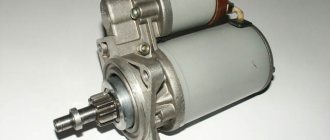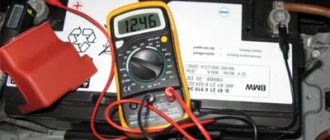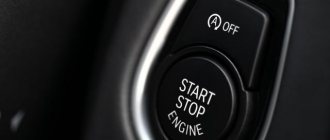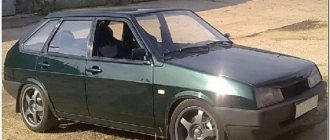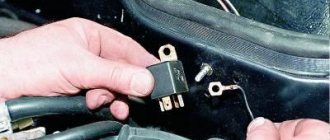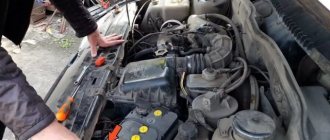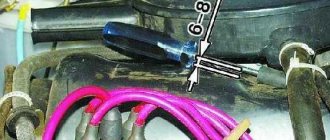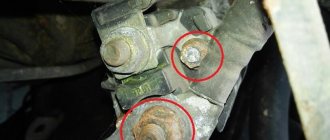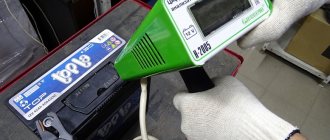Noises when starting a cold car, which can provoke them
Below we discuss in detail the main most common types of abnormal noises when starting a machine when cold, as well as their possible causes:
- The sound of the engine being difficult to start. When starting off in a cold environment, a low intensity of headlight light is noted, and a sensation of sound is perceived, as if the car is starting without force. This is a symptom caused by problems with the battery (low charge or in poor condition) or the terminals (possibly making poor connections).
- “Skating” starter (“grrrrrrrrr…”). If the car starts to make friction noise between the gears when starting from a stop, there may be a problem with the starter.
- Engine noise (“chof, chof...”). If you hear a noise when starting a cold engine that sounds like “chop, chof...” and there is a strong smell of fuel inside the car, it is possible that the injectors are no longer sealed or are in poor condition. The noise that the injectors produce is very distinctive and this is due to the effect of fuel vapors escaping to the outside of the valve covers.
- Metal friction noise. It may happen that when starting the engine cold, a friction noise was heard between metal parts from the engine area. This situation may be a symptom caused by a faulty water pump. This metallic noise can occur when the water pump turbine comes into contact with the pump housing itself.
- Metallic noise (ringing) from the exhaust area. Sometimes, it may happen that some leak protector or clamp is loose or cracked. “Ringing” is produced by a metal part that has become loose or has cracks.
- Creak from inside the car. If there is a noise when starting the car when it is cold and it sounds like a squeak coming from the inside of the car, it is possible that the heating fan is in poor condition (the balance axis is probably broken or there is a lack of lubrication).
- The sound of metal sheets vibrating when starting up. The noise from vibration of metal sheets when starting is usually associated with the poor condition of the pipe protectors. These protectors can crack or break due to external factors such as temperature, mechanical stress, etc.
- Creak in the engine area. A creaking sound in the engine area when starting off may occur due to a timing belt pulley or tensioner in poor condition. This happens because the rollers or tensioners may become loose
- Intermittency or knocking noise in the engine compartment area. This noise when starting the car when cold occurs, as a rule, due to the timing chain being in poor condition (stretched or faulty). In this case, the chain cuts into the skates and produces these knocking noises, especially if the engine is not hot.
- Vibration of plastic in the engine area (“trrrrrrr…”). Vibration, changes in temperature or aging of the material can be caused by the fact that the cover that covers the engine is cracked or its supports are damaged, and, accordingly, vibrations of the plastic are heard.
- Metallic noise exactly during startup, accompanied by vibration in the body and steering wheel. This symptom can be considered if the engine pistons are in poor condition. These symptoms may lead to a more serious problem.
- A noise, as if metal was ringing at the start (“klo, klo,...”). When starting off, there may be a noise, a ringing of metal caused by a steering wheel failure. This can be caused by the steering wheel being unbalanced, causing vibrations that cause this noise. He's very characterful.
- Loud whistle in the engine compartment. Another possible noise when starting a car in cold weather is a whistle from the engine compartment, which may be caused by a defect in the exhaust manifold. A crack in this part, or a gasket in poor condition, both of which can create such a loud whistling noise.
- Engine chatter or discordant noises. There is a possibility that this kind of noise occurs in the engine when internal parts fail. As a rule, this malfunction is difficult to determine, since in order to accurately diagnose it, you need to disassemble the engine.
Engine whistling when starting and running
It's always nice to know that your car is in full working order and will not cause inconvenience at the most inopportune moment. However, this does not always happen and many car owners are faced with a number of manifestations of failure of some car parts. This makes people doubt their “iron horse”, and such a car will clearly not add positive emotions. The most common signal of a breakdown is a whistle when starting the engine. Moreover, it is faced not only by owners of old cars, but also by practically new ones that have recently left the dealership.
The reason why a whistle is heard when the engine is running can be a number of different malfunctions in the car engine. Usually this is not so much a dangerous sign as it is annoying. Although, if the engine begins to make such extraneous sounds and the engine whistles more and more, then it is clearly impossible to delay the elimination of this problem. Some ignored faults can lead to expensive repairs and a host of problems.
Belts
One of the main reasons for whistling when starting the engine is the belts of various drives in the engine compartment of the car. Poor tension and wear lead to the appearance of that same annoying whistle, which can intensify with increasing engine speed. Or, on the contrary, it may disappear when you press the gas pedal. In any case, the sound made by the belts is very audible and impossible not to notice.
When a whistle occurs, the first thing you need to do is check the tension of the drive belts.
The first step is to check the tension of all drive belts in the engine. If any of them is weakened, then it may slip, which leads to a whistle when the engine is running. In this case, you need to tighten the belt to the permissible limits in order to leave it with normal free play. Another reason for belt slippage can be dirt and oil that gets on them. In this case, it must be thoroughly cleaned, and it is best to replace it with a new one.
Recommendations
There are many possible abnormal noises during cold engine starting. When they are detected, it is important to have the vehicle checked as soon as possible, as these noises could be hiding a serious problem, or it could be a harbinger of a future serious problem.
To eliminate any type of noise when starting a car when cold, it is highly recommended to contact a workshop. Answer 2 important questions: “what noise?” and “where does it come from?” This information will help technicians diagnose the problem.
Some of these noises are caused by worn or broken parts, plastic or metal. In many cases, it is not possible to replace the part (due to their high cost, lack of goods, etc.) and, to eliminate the malfunction, in such cases, it is recommended to use two-component glue.
Source
What's the result?
As you can see, any problems with starting the engine are a reason for diagnostics. Moreover, if the culprit is the starter, then the problem often tends to progress.
Such symptoms indicate that in the future there is a high probability of needing to repair/replace not only the starter itself, but also the flywheel (and the flywheel itself is an expensive part). For this reason, it is optimal to perform starter diagnostics immediately after the first signs of malfunction appear.
The starter clicks and/or buzzes, but the engine does not turn over. The main causes of starter failures, diagnosing and troubleshooting them yourself.
Why the starter may not work after turning the key in the ignition. The main causes of starter malfunctions: bendix, traction relay, brushes, winding.
Voltage drops when starting a car engine: main reasons. Diagnosis of possible malfunctions, checking the generator, starter, battery, etc.
Why does the starter turn normally, but the engine does not catch and does not start? Main causes of malfunction, checking fuel supply and ignition systems. Adviсe.
Internal combustion engine starting system: electric and air starting of the internal combustion engine. Operating principle, operating features, recommendations.
What to do if the starter turns, but the engine does not crank. Checking the power supply system, ignition, electronic control of the internal combustion engine, etc. Recommendations.
Possible starter malfunctions
In the article “How to start a Niva,” I told you how you can determine the area of damage to the car in road conditions by looking at the banners on the instrument panel and by external inspection.
In this article I will talk about possible malfunctions of the starter and its activation circuits and what can be done in road conditions.
Problems with the starter can be determined by the sound or lack thereof when the engine starts.
Look at a simple starter circuit diagram. From which it can be seen that in order for the starter rotor to start rotating, two relays must be activated. The starter activation relay, located under the instrument panel, and the solenoid relay on the starter itself. During normal operation of the starter, they both make clicks, but, as a rule, we do not hear them, since they occur simultaneously with the start of rotation of the rotor and are drowned out by the noise from the engine starting.
The following options are possible.
When turning the key in the ignition switch, there is no sound of a rotating starter or relay clicks.
This may indicate a faulty starter relay, damage to the ignition switch or connector connections. It is difficult to get to the starting relay, so you need to find, under the hood, the red wire coming from the starter with a detachable connection, indicated in the diagram by a yellow rectangle with an arrow, and disconnect this connection. Extend the wire coming from the starter with a spare wire, reaching the other end to the positive terminal of the battery. Place the gear shift lever in neutral position. Put the car on the parking brake. Turn on the ignition. If the engine is cold, then close the carburetor air damper completely, and if it is warm, then tighten the air damper control knob halfway. By touching the free end of the extended wire to the positive terminal of the battery, try to start the engine. If the assumption was correct, and everything else is in order, the engine should start or we will hear the noise of the rotating engine shaft. After starting the engine, you can drive to the service center.
When the starter is turned on, a relay click or a series of clicks is heard, the starter remains motionless.
This may indicate damage:
discharged or damaged battery;
bad (oxidized) contacts on the battery terminals;
electrical connection of the negative battery cable to the car body; electrical connection of the car body with the engine block;
You can check these assumptions using a probe (a car light bulb with a power of at least 27 W). To do this, connect the flexible wire of the probe to the “+” terminal of the battery, and with the probe probe, first touch the “minus” terminal. The bright light of the probe light indicates the health of the battery and the serviceability of the contact being tested. Burning of the lamp at full intensity or lack of incandescence indicates damage to the battery or poor (oxidized) contact. Consistently touching the terminal on the negative terminal of the battery, then touching any unpainted bolted connection on the car body and engine, check the reliability of the electrical connections. If a bad connection is detected, it must be disassembled, cleaned, reassembled and checked with a probe.
If the battery is discharged, you can try to start it from the battery of another car using special copper wires with a cross-section of at least 16 square meters. mm.
If the starter is damaged, you can start the engine from a tow.
In order to start from a tow, you need to engage second or third gear, turn on the ignition, and squeeze the clutch. When the car accelerates to a speed of 5-10 km/h, smoothly release the clutch and press the accelerator pedal. As soon as the car starts, depress the clutch and use the choke to set the engine speed to a stable speed.
Mechanical damage to the starter
This is when the starter rotor rotates but the engine flywheel remains stationary. This happens due to damage to the overrunning clutch, lever and drive gear, wear of the teeth on the flywheel ring, or a banal loosening of the starter’s attachment to the car’s engine. Only the latter can be corrected in the field by tightening the accessible starter mounting bolt. Other damage requires qualified repairs.
Causes of malfunction
Before we begin to study the causes of the malfunction, we remind you that hereinafter we are talking about the crackling noise of the starter, which is most similar to the loud rattling of the contacts of an electromagnetic relay. If you hear an unpleasant metallic grinding noise from under the hood, then it appears due to poor engagement of the overrunning clutch (starter Bendix) with the flywheel teeth - that’s a completely different story.
Most often, the starter crackles when you turn the ignition key for three reasons:
Low battery
To understand the cause of the crackling noise due to a discharged battery, let's remember the starter device. When you turn the ignition key, the voltage from the on-board network is supplied to the coil of its solenoid relay. The electromagnetic forces that appear in this case cause the armature of the device to move. It closes the power contacts that connect the starter motor to the battery, and in addition, causes the Bendix gear to engage with the flywheel.
When the battery is discharged, its energy may be enough to attract the metal core - cranking the crankshaft is out of the question. As soon as the starter contacts close and power is supplied to its electric motor, the voltage drops to such an extent that the electromagnet is unable to hold the metal core. Under the action of the return spring, it tends to take its original position and opens the power contacts. The restored voltage contributes to the repeated retraction of the anchor, and the situation is recreated many times.
To make sure that the culprit of the problem is a deep discharge of the battery, just turn on several consumers (lighting, electric heater motor, etc.) and press the sound signal. The latter will either not turn on at all, or will be heard with wheezing, reduced amplitude or attenuation.
Poor engine ground contact
The picture of what is happening is practically indistinguishable from the case discussed above, with the only difference that the test for battery discharge ends with a negative result - all consumers, including the sound signal, are working at full strength.
Read also: Linear speed formula of the earth
At the same time, it is very simple to determine that the cause of the malfunction is poor contact between the battery and the engine - just pay attention to the oil pressure warning lamp, which is located on the instrument panel. If the voltage in the car’s on-board network is below normal, then turning the ignition switch to the “Start” position will lead to a gradual attenuation of the brightness of the warning lamp (like all others).
In the case where the cause of the crackling sound of the starter solenoid relay is a bad ground, an attempt to start the engine will lead to its complete extinction in time with the clicks of the solenoid relay. At the same time, other indicators practically do not change the intensity of the glow.
Everything is explained very simply - the “mass” of the oil pressure sensor, as well as the starter, is the housing. Therefore, as soon as the electrical contact between the engine and the battery is lost, both of these devices stop working synchronously.
Open or shorted starter relay winding
Another reason why the solenoid relay cracks is an interturn short circuit or a break in its holding winding. In other words, the efforts of the electromagnet become insufficient to keep the power contacts of the starter relay in the closed state and engage the overrunning clutch gear with the flywheel ring gear. Under the action of the return spring, the bendix tends to take its original position, and the contact pad located on the armature opens the electrical connection. After this, the retractor winding turns on again and the situation repeats itself many times, which causes the crackling noise.
to determine that in this case the starter solenoid relay has failed by the behavior of the warning lamps located on the instrument panel. At the moment when the loud clicks of the starter are heard, their brightness does not change - the switching of the starter motor occurs for such a short time that the battery voltage practically does not drop.
Something else useful for you:
What is a starter and how does it work?
Let's briefly touch on the basics.
So, the starter is based on a DC electric motor. At the front end of its shaft there is a sliding coupling and a gear, which at the moment of start-up engages with the teeth of the engine flywheel. The movement of the clutch is ensured by a retractor relay located on the starter housing. At the moment of startup, the relay rod moves and pulls the fork, which pushes the clutch and gear into the position of engagement with the flywheel.
The traction relay coil has two windings.
- Retracting. Connects when the key is turned to the “start” position. It ensures movement of the relay rod. After the first winding is triggered, the rod moves and moves the contact “penny”, closing the contacts with it, including the starter motor and the second, holding winding.
- Holding. It is needed to keep the rod retracted as long as the key is in the “start” position.
Accordingly, all malfunctions come down to either problems with the retractor, or with the electric motor itself, or with the clutch.
As a rule, the starter refuses to start the car at the most inopportune moment and completely unexpectedly. That is, yesterday everything was fine, but today we turn the key to the “start” position, but it doesn’t turn... or it turns but somehow not the way it should, or it makes strange sounds. In any case, there is no need to wait for a miracle; it will not go away on its own. Let's try to find and fix the problem.
How to fix a rattling starter
The method for troubleshooting depends on what is causing the problem. If the starter cannot work normally due to a discharged battery, it is enough to charge it to the required parameters. Typically, charging is carried out with a current of 0.1C, where C is the battery capacity in ampere-hours. At the same time, highly discharged current sources and calcium batteries should be charged with low currents (1-2 A) to at least 25% charge (this parameter is controlled by the density of the electrolyte). The gentle mode will take more time, but will protect the battery from many negative aspects.
Note! Often, when the battery is discharged, car owners try to start the engine “from a tow”. Note that this method is only suitable for the simplest power units, but not for injection engines. Launching the latter “from the pusher” often leads to a failure of the electronic control unit software.
In this case, the ECU begins to behave unpredictably - for example, request permission to start from a disabled immobilizer. The situation can only be corrected by reflashing the “brains”, and this, as you yourself understand, is an additional and completely unjustified expense.
In the case where the cracking of the solenoid relay occurs due to poor contact with the vehicle ground, it is enough to simply restore the electrical connection. To avoid problems in the future, it is recommended to remove the tire that connects the engine to the body and clean the contact pads with sandpaper. A thin layer of technical Vaseline or VD-40 universal lubricant will help prevent their oxidation.
Read also: Stabilizer strut Renault Logan
If the source of the malfunction is the retaining winding of the starter solenoid relay, then try to repair it. If this is not possible, then a decision is made to replace the solenoid relay assembly. As you can see, even a novice driver can cope with finding the fault that is causing the starter to crack.
The starter turns sluggishly
As a rule, low voltage in the on-board network is to blame. Therefore, start by checking the ignition system
.
If everything is normal with the battery, and the voltage on it is 12 V or more, check the condition of the terminals. The most common cause is poor contact. Clean the terminals thoroughly from oxides, lubricate them with grease (litol, grease, etc.) and secure well. You shouldn’t pull the terminals too hard, as this will deform the battery terminals, which are made of lead, and the wire terminals themselves, which are now made from something completely unknown.
Check if there is ground on the body and engine. To do this, simply select the resistance measurement mode on the multimeter and measure it between the negative terminal of the battery and the motor, and then between the terminal and some unpainted bolt on the body. The resistance should be close to zero. If this is not the case, inspect the attachment of the negative wire to the engine and check the integrity of the “pigtail” connecting the engine and the body. It is attached to the clutch bell.
The starter doesn't turn at all
The problem could be:
- in the wiring;
- in the retractor;
- directly in the starter motor.
Let's start looking for the problem with a simple one.
Let's inspect the connection
- Check anti-theft systems. Perhaps they are joking with you.
- Perhaps your battery is simply discharged.
- If there is a fuse for the starter circuit, check its integrity.
- Let's check whether +12 V voltage appears at the starter control contact (this is a thin screw on the solenoid relay). If there is no voltage, then we will check the additional starter relay and the ignition switch.
- Have a helper turn the key to the start position and listen. Does the starter make any sounds? It is possible that your solenoid relay rod is jammed. It works, indicated by a click, but its movement is limited.
Let's check the retractor
If voltage comes to the control contact of the retractor relay, the ground is not broken, but the starter refuses to cooperate with you and does not turn, do the following.
- Be sure to remove the car from gear and put the handbrake on;
- Turn the key to the “ignition” position;
- We take a 17mm wrench and use it to bridge the power terminals of the retractor.
If the starter spins vigorously, then our problem is in the solenoid relay itself. The easiest way would be to simply replace it with a new one, but you can try to repair it.
Disassembling the starter
If the problem is not in the retractor, let's check the starter motor itself.
We remove it from the car and disassemble it. There is nothing particularly complicated here.
- Unscrew and remove the retractor.
- Remove the retractor rod.
- Remove the starter rear cover by unscrewing the two screws securing it and removing the retaining half-ring in the center.
- Slide the motor stator along with the housing off the studs.
Now you need to carefully examine the condition of the collector contact pads. If they are very worn, you can try sanding them to a smooth surface.
We look at the wear of the brushes. We change them if necessary.
Using a multimeter, we check whether the windings are shorted to the housing, and that there are no internal short circuits or breaks in the windings. If there are any, we take the starter for repair or replace it with a new one. You can't do anything here on your own.
Starter operating principle
The overrunning clutch or bendix is one of the most important components of the starter. When the engine starts running, the starter is in close proximity to the flywheel, and it is the overrunning clutch that is the mechanical means that, after starting the engine, removes the starter from the flywheel. If the overrunning clutch does not fulfill its task, the flywheel, spinning the starter, actually leads to its destruction. For the car owner, this problem is expressed by a squealing sound when the engine starts.
Possible causes of malfunction
- high degree of wear of the overrunning clutch;
- damage or severe contamination of the spline on which the overrunning clutch is attached;
- malfunction of the overrunning clutch drive (“fork”).
The most common problem that causes the starter to squeal can be considered the second problem, and it is in the form of contamination. But you can eliminate the problem literally in no time - just clean the starter.
The starter makes strange noises
Crackling or grinding noise when starting the engine
This sound occurs when the starter gear does not fully engage with the flywheel ring teeth. There may be several reasons, and most of them can be easily eliminated.
- The connection between the starter and the clutch bell is loose. It happens. Just try to shake the starter by hand; if it does not fit tightly, tighten the nuts securing it to the required torque and try to start the engine. Most likely, the scary sounds will disappear.
- Insufficient starter sliding clutch movement. The gear just doesn't fit into place. Usually the culprit is a mud-covered shaft. To restore functionality, remove the starter
from the car. Next, clean the shaft and lubricate it with good grease. Check the movement of the gear; there should be no jamming. - The fork moving the sliding clutch may be to blame. It happens that it breaks or becomes deformed, although this is rare. In both cases, the plug needs to be replaced.
- The flywheel crown is corroded. You can easily see this problem by removing the starter and simply looking into the hole in the clutch bell. There are several solutions to the problem: replacing the flywheel, replacing the crown (the old one is knocked down, and the new one is heated and pressed hot onto the flywheel), you can try turning the old crown over (we heat the crown and press it off the flywheel, heat it again and press it on the reverse side).
The fastening of the starter retractor to the housing has become loose. The result is incomplete movement of the gear. Tighten the fasteners.
Metallic ringing from the clutch bell when the engine is running and sometimes a grinding noise when starting
Most likely, you will find out when you remove the starter. that his “beak” was broken off. This happens for various reasons. The starter may have been poorly attached to the bell, or it may have been tightened misaligned, there may be a casting defect, or there may have been excessive movement of the gear. It makes sense to weld the “beak” into place with argon only in the case of free access to the welding machine; in all other situations, it is better to replace it. But since you are unlikely to be able to find the “beak” separately, you will most likely have to replace the starter assembly.
Replacing the starter drive
This operation is identical on different brands and models of cars, since the electric drive designs have similar structures. The element in question may differ in dimensions, the presence or absence of a gearbox, and the material used to make the fork (plastic or metal). Replacing the Bendix will require no more than 20-30 minutes after removing the starter from the car.
The fasteners of the rear cover are unscrewed, and the ring-shaped stopper is removed from the rotor. A pair of tightening nuts is unscrewed. After disconnecting the stator winding from the brushes, the parts of the assembly are disconnected. The body and lamellas of the part are cleaned, the condition of the brushes and bushings is assessed. After removing all parts of the starter, the rotor remains in the front cover. At its edge there is a locking ring with a holder, which, with a light tap, moves towards the winding.
Using a screwdriver or puller, the stopper is removed, the old bendix is dismantled, and a new version is installed in its place. Before assembly, it is advisable to treat the splines with graphite lubricant or its analogues.
Read also: Lada Vesta Cross with all-wheel drive
